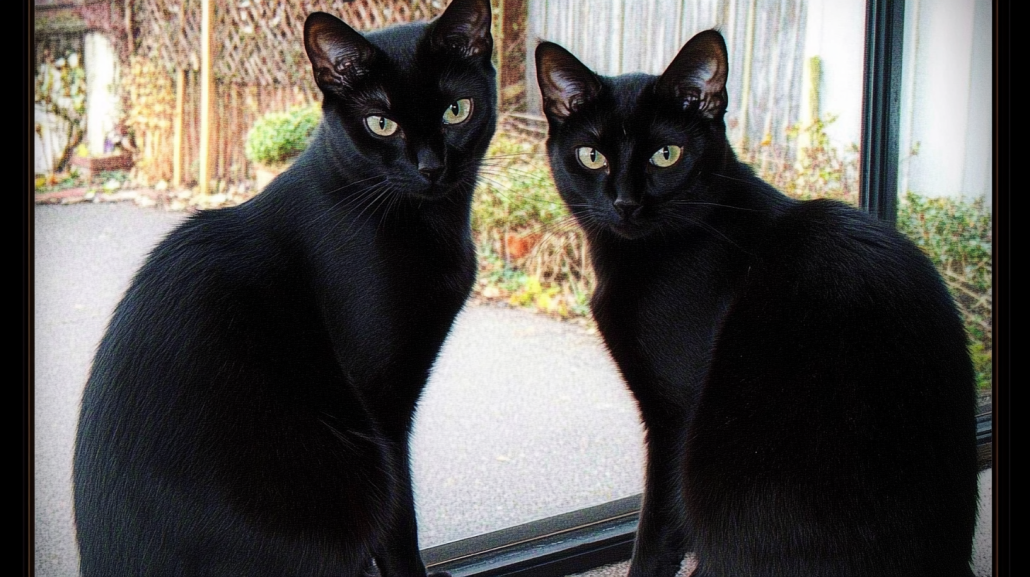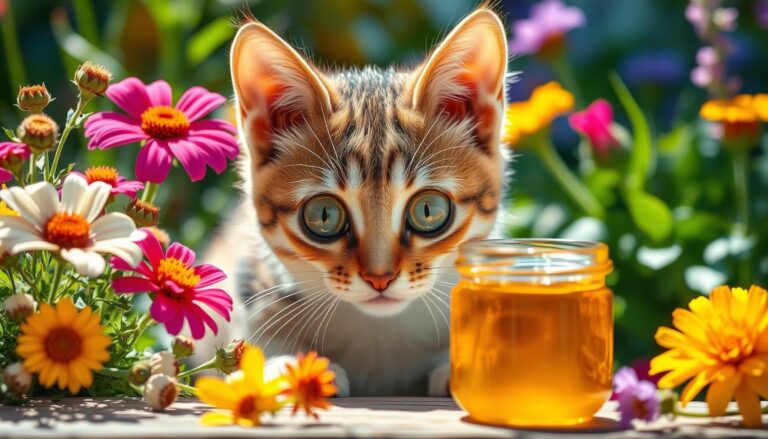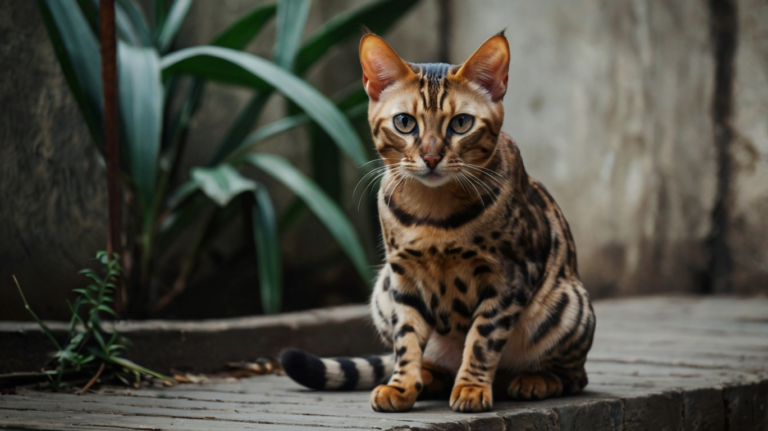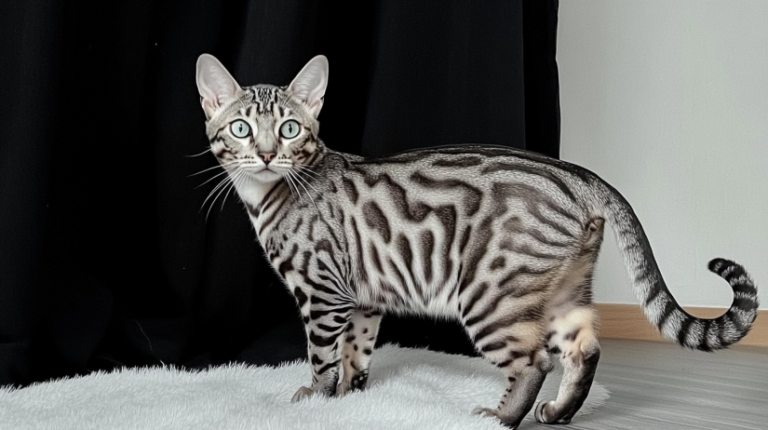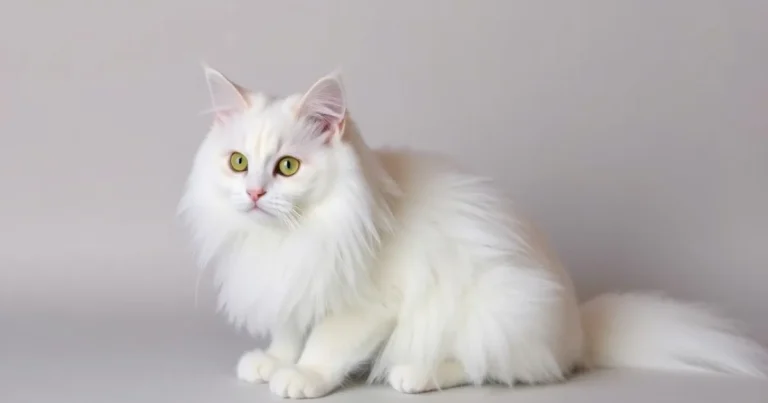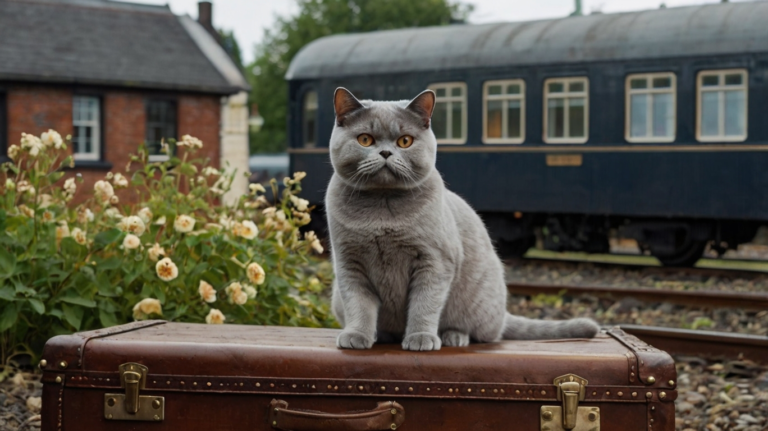Black Savannah Cat: 7 Positive & Thrilling Secrets
Introduction
What if you could have a cat that looked as though it wandered straight out of an African savannah—long legs, upright ears, a confident stance—yet possessed the deep, velvety color of midnight? That’s the dream many pet lovers envision when they fall for a black savannah cat. This color variation on the increasingly popular Savannah breed merges an exotic wild-cat appearance with the sleek, shadowy mystique of a glossy black coat. The result? An utterly captivating feline that moves through your home like a shadowy panther, purring at your feet and scaling cat trees in the blink of an eye.
But adopting a black savannah cat isn’t just about aesthetics. These hybrids descend partly from the African serval, meaning their energy and intelligence can outstrip what a typical domestic cat requires. Are you prepared to meet a cat that can leap onto high shelves, learn how to open doors, and demands daily engagement to stay content? In this comprehensive guide, we’ll walk you through the origin, care regimen, potential challenges, and joys of owning a black savannah cat, ensuring you have the knowledge to make an informed decision on bringing one of these midnight-hued marvels into your life.
Background of the Savannah Cat Breed
Hybrid Origins
The Savannah breed sprang from crossing a domestic cat (often a Siamese or other short-haired variety) with the African serval, a mid-sized wild feline known for tall ears and extraordinary leaping skills. The first documented Savannah kitten was born in 1986, setting off a wave of fascination and subsequent breeding programs. Over time, recognized breeders refined the line to stabilize temperament, coat patterns, and size—leading to the official acceptance of the breed by The International Cat Association (TICA) in 2001.
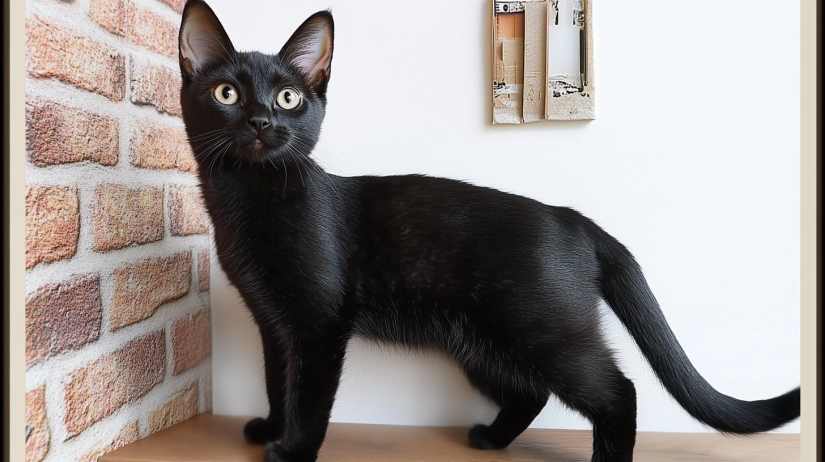
Generational Naming (F1, F2, etc.)
Savannahs are often labeled with “F” designations (e.g., F1, F2) that describe how many generations removed they are from a serval ancestor:
- F1: One parent is a serval, the other a domestic cat.
- F2: Grandparent is a serval, two domestic cat grandparents.
- F3 or later: More domestic cat lineage, fewer wild traits.
Early generations (F1–F3) usually display more pronounced wild instincts and larger size. By the time you reach F4 or F5, you have a cat that’s more akin to typical domestic felines in temperament. A black savannah cat can occur at various generational levels, but coat color depends more on the specific genes inherited from both sides.
Coat Color Variations
Savannah cats commonly come in spotted or marbled patterns, featuring shades like brown, silver, black, and even “black smoke.” However, a fully black savannah cat is considered somewhat rarer. These cats often retain faint “ghost spots” only visible under bright light or certain angles, reminiscent of their spotted ancestry. Their undercoat, if black as well, helps produce that deep, uniform hue we label “solid black.” If the undercoat is lighter, they might appear “black smoke” with shading at the hair roots.
Defining the Black Savannah Cat
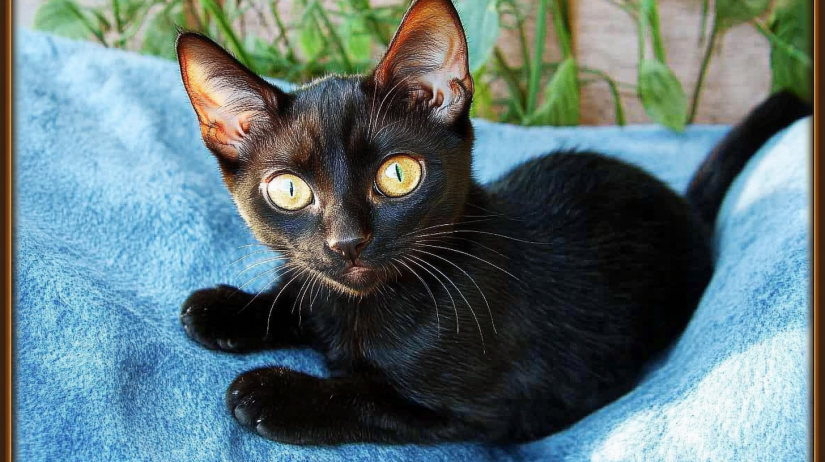
Genetic Explanation
In Savannahs, the black coat arises when a cat inherits two copies of the recessive gene for solid black coloration, overriding the typical tabby/spotted pattern. That same gene can also express partially in some lines, resulting in black smoke coats or black with faint spotting. The exact shade—whether it’s an inky black or a slightly dusty charcoal—can vary. For your black savannah cat, it’s simply the expression of these color genes layered atop the breed’s standard morphological traits.
Physical and Behavioral Traits
Aside from their coat color, a black savannah cat typically displays:
- Long, athletic legs: Relative to body size, reflecting their partial serval ancestry.
- Large, upright ears: Placed high on the head, giving a keen, alert appearance.
- Tendency to be tall: Especially in early-generation Savannahs, they can stand up to 16 or more inches at the shoulder.
- Intelligent and inquisitive: Known to figure out how to open cabinets or doors if bored.
Compared to “standard” spotted Savannahs, the difference is purely aesthetic. Behaviorally, black Savannahs require the same environment and handling as any other color.
Appearance vs. True Serval Hybrids: Clearing Confusions
Not a Pure Serval
A fully black serval is exceedingly rare in nature (most servals have spotted coats). Even if one existed, it’s genetically different from a black Savannah, which typically includes multiple domestic cat lines in addition to the serval contribution. Some unscrupulous sellers might label a cat as a “black serval” to inflate prices, but truly verifying parentage and lineage documents is crucial.
Differences from Other Wild Hybrids
Some exotic cat lovers might compare the black savannah cat to a melanistic Bengal or even a black Chausie. While all are hybrid or hybrid-inspired cats, each breed has a distinct origin. Bengals, for example, come from crossing domestic cats with Asian leopard cats, while Chausies cross with the Jungle cat (Felis chaus). Savannahs specifically incorporate African serval lineage.
Living with a Black Savannah Cat: Daily Routines and Requirements
Nutrition and Feeding
Savannahs demand high-quality, protein-rich diets to support their active lifestyles and muscle mass. Many owners opt for premium grain-free dry kibble or wet food, sometimes supplemented with occasional raw or freeze-dried treats. black savannah cat dietary needs mirror those of spotted Savannahs—no special color-based differences exist. Keep an eye on portion sizes: though active, these cats can become overweight if overfed.
Exercise and Stimulation
black savannah cat routines should cater to their high energy:
- Interactive Toys: Laser pointers, feather wands, puzzle feeders.
- Climbing Opportunities: Cat trees, wall-mounted shelves, or window perches.
- Leash Training: Some owners teach Savannahs to walk on a harness—perfect for exploring the yard or nearby park.
- Play Sessions: At least 15–20 minutes, 2–3 times daily, or as needed to keep them engaged and well-exercised.
Insufficient stimulation can lead to destructive behaviors, so plan to invest time and resources into structured play.
Social Interaction
Savannahs are more social than many cat breeds, often seeking out your company or following you from room to room. A bored or lonely black savannah cat might become vocal, attempt escapes, or even damage household items searching for stimulation. If you work long hours, consider adopting a second cat or scheduling daily interactive sessions to curb restlessness. With children or other pets, early, supervised introductions are key to building positive relationships.
Grooming
While short-haired, Savannahs do shed modestly. Weekly brushing or combing helps remove loose fur and fosters bonding time. Bathing isn’t usually necessary unless they get particularly dirty, though some Savannahs tolerate water better than average domestic cats due to their partially wild heritage. black savannah cat coats may show dust or dander more visibly if they have any dryness or flakes, so ensuring good nutrition and occasional brushing keeps the coat glossy.
Potential for Escape
Savannahs, especially early generations, can jump impressively high—some say up to eight feet or more in a single bound. Ensure windows, balconies, or any open vents are secured to prevent your curious black savannah cat from leaping into unintended adventures outside. Microchipping and ID collars are recommended in case they dash out a door during a moment of opportunity.
Training and Socialization
Start Early
Socialization ideally begins as kittens—black savannah cat or otherwise—exposing them to household noises, varied people, gentle children, and perhaps calm dogs. The earlier the cat grows comfortable with these experiences, the less anxious or wary they become as adults.
Positive Reinforcement
Given their intelligence, Savannahs respond especially well to reward-based training:
- Treat-based lures: Pair the command (“sit,” “come,” etc.) with a high-value treat.
- Clicker Training: Marking correct behavior with a clicker, then praising immediately.
- Short Sessions: Keep training intervals brief but frequent to maintain your cat’s enthusiasm.
Problem Behaviors
A bored or understimulated black savannah cat might exhibit:
- Biting or Nipping: Usually, a sign of frustration or unchanneled energy.
- Sporadic Spraying or Marking: Especially if unaltered, or feeling stressed.
- Furniture Scratching: Provide tall, sturdy scratching posts or boards as alternatives.
Address them by boosting playtime, rotating new toys, or consulting a feline behaviorist if issues persist.
Health and Wellness
Typical Lifespan and Vet Care
Savannah cats, including your black savannah cat, can live 12–15+ years with appropriate care. Key to longevity:
- Regular Checkups: Annual or biannual vet visits for vaccinations, parasite prevention, dental checks.
- Spaying/Neutering: Helps control hormones and reduce behaviors like roaming or spraying.
- Routine Blood Tests: Especially for older cats to catch early signs of kidney or liver issues.
Because they’re partially a newer breed, fewer breed-specific diseases are well-documented, but some lines may be prone to hypertrophic cardiomyopathy, patellar luxation, or other genetic conditions. Always buy from breeders who perform relevant health screenings.
Potential Health Issues
- Hypertrophic Cardiomyopathy (HCM): Some lines might predispose.
- Urinary Tract Problems: A high-protein diet plus hydration can help mitigate.
- Dental Disease: Like many cats, Savannahs can suffer gum or tooth issues—regular brushing or dental treats recommended.
Should you notice changes like decreased appetite, lethargy, or abnormal bathroom habits, contact your veterinarian promptly.
Important Considerations About Hybrids
Focus on legalities: While legal in many U.S. states, certain states or municipalities restrict or prohibit ownership of hybrid cats (like F1–F4 generations). Check local exotic pet laws before adopting a black savannah cat. Additionally, confirm your chosen veterinarian has experience with exotic or hybrid cats so you can receive more specialized advice.
Are Black Savannah Cats Rare?
Though many people associate Savannah cats with spotted, golden coats reminiscent of the African serval, the black savannah cat is indeed less common:
- Breeding: Producing a true solid black pattern requires both parents carrying the recessive gene for full melanism.
- Demand: Some owners specifically seek unusual coat colors, raising the cat’s market value and perceived “rarity.”
- Visibility of Spots: Many black Savannahs still retain ghost spots, only noticeable under bright light or from certain angles.
While color alone doesn’t dictate personality or quality, a solid black coat can add an air of elegant mystery, forging a strong aesthetic appeal among enthusiasts.
FAQs
Do Savannahs show hostility toward people?
Generally, no. A black savannah cat can be assertive but rarely hostile if raised kindly. Adequate socializing ensures they bond confidently with humans.
Are black Savannahs suitable for homes with kids?
They typically do great with respectful youngsters. A black savannah cat loves interactive fun but needs adult oversight. Proper guidance nurtures a safe, happy dynamic between cat and child.
Are grooming requirements different for black coats?
Not really. A black savannah cat only needs regular brushing and standard grooming. Their dark fur might highlight dirt more, so routine care ensures a sleek appearance.
Does solid black coloration boost the cat’s price?
Often, yes, if it’s viewed as rare. A black savannah cat may fetch a premium among enthusiasts seeking unique looks. Still, generation and health screenings affect final pricing too.
Is it lawful to keep a black Savannah in my area?
Rules vary by region. A black savannah cat might fall under hybrid cat bans or require permits. Verify local ordinances and compliance steps before buying or adopting.
Can black Savannahs peacefully share a home with other animals?
Yes, if introduced carefully. A black savannah cat raised around pets usually learns to get along. Monitoring initial encounters helps establish positive dynamics.
Conclusion
The black savannah cat merges an elegant, midnight-hued coat with the bold personality that defines the Savannah breed—combining exotic looks, high intelligence, and a spirited approach to daily life. While their allure is undeniable, you should thoughtfully consider their needs: space to leap, puzzle toys to challenge them, socialization to channel their energy productively, and respect for any local regulations or ethical considerations tied to owning a hybrid. If you can provide that environment, your black savannah cat can blossom into a loyal, playful, and surprisingly affectionate companion who stands out both visually and temperamentally. Have stories or questions about your own black Savannah, or dreaming of adopting? Join our community in the comments below, and let’s celebrate these sleek, ebony-hued wonders together!
For more insights on adopting hybrid or exotic felines responsibly, check out resources from the
American Society for the Prevention of Cruelty to Animals (ASPCA)—a trusted organization offering guidelines on ethical pet ownership, spay/neuter programs, and more.

